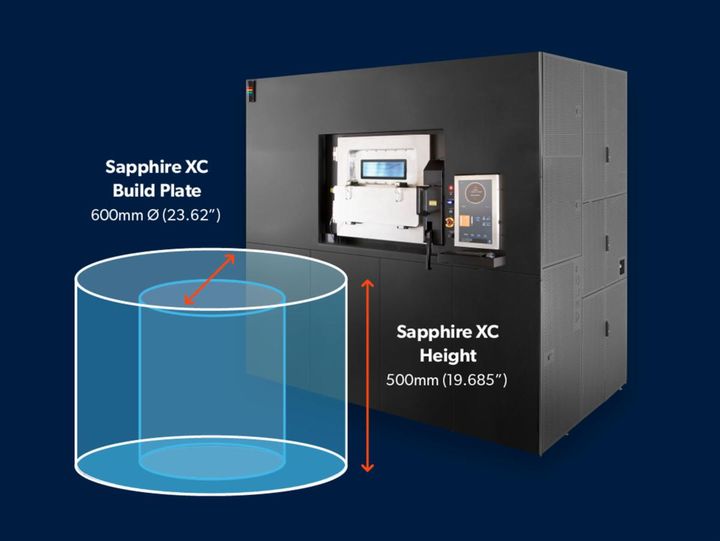
VELO3D suddenly announced a brand new 3D printer, the Sapphire XC, which is far larger and much faster than their previous 3D printers.
The California-based company has made their name by a combination of hardware, software and precision tuning to transform the commonly used LPBF process into a much more reliable and effective method of producing complex metal parts. Their Sapphire 3D printers and their advanced recoater are so well-tuned that in most cases you don’t even need to use support structures.
That’s fantastically important in metal 3D printing, as supports transfer heat and vastly complicate the execution of a print job. Support structures also require considerable effort to remove after 3D printing completes, and of course consume an amount of expensive metal powder as well.
With these successes in hand, VELO3D has sought to increase the print volume to allow more clients to partake in the technology. Previously they adapted their original Sapphire device into a “stretch” version, the Sapphire 1MZ. This machine is essentially the original Sapphire device with a larger Z-axis. By retaining the original cylindrical cross section (the VELO3D devices use a cylindrical build volume), the company was able to easily create the 1MZ because the majority of the tuning elements were simply retained.
Sapphire XC 3D Printer
Now the company has taken a more dramatic step with the introduction of the massive Sapphire XC. While they have boosted the Z-axis to 550mm from the original Sapphire’s 400mm, they have also enlarged the build volume diameter from 315mm to a huge 600mm. This change embiggens the build volume by 4.9X, or as VELO3D puts it, “5X”.
The increased build volume introduces a problem faced by many large-format 3D printers: build durations.
Early makers of large-format 3D printers found that while it was relatively straightforward to scale up extrusion technology, the build times became vastly longer. In machines 3D printing the same layer height, objects of twice the diameter take ~4X as long to 3D print. I recall seeing some early large-format 3D printers taking literally weeks to complete huge jobs.
Clearly VELO3D didn’t want to subject their clients to the same duration effects, and so they have taken an unusual step to rectify the print speed: they have added more lasers.
Yes, this has been done previously by other companies. The idea is to have lasers operating simultaneously on each layer, and this parallel operation can speed up processing immensely. VELO3D themselves have already done this on their original Sapphire machine, which has twin 1kW lasers.
LPBF machines from a very few other 3D printer manufacturers have involved as many as four lasers in a machine. Typically these are assigned “zones” in which they operate and don’t overlap.
But VELO3D has taken the incredible step of adding EIGHT lasers to the Sapphire XC. To understand how important this is, consider that in theory this machine would run up to eight times faster than a single laser machine. Or, in their case, 4X faster than their original twin-laser Sapphire machine.
VELO3D says the Sapphire XC’s lasers are all 1kW power, suggesting that you’ll need a hefty electrical connection to run this device at full speed.
VELO3D also says all the learnings and features from the previous Sapphire systems have been incorporated into the Sapphire XC. This means that the incredibly precise 3D prints obtained on their older equipment can also be produced on the Sapphire XC — except a lot larger.
The combination of higher volume and speed could prove irresistible to some manufacturers who seek ways to produce highly complex large metal parts. I suspect there are multiple aerospace companies licking their chops at the thought of this machine.
Why? Because the complex machines and components used in aerospace depend on weight, and the lighter the better. By being able to 3D print larger parts, a Sapphire XC operator could avoid splitting a large component into multiple parts. That’s never desirable, because the seam between assembled parts becomes a potential failure point, and there is added weight for lugs and bolts to hold the parts together. Instead, a Sapphire XC operator could simply print the large component in one piece.
Sapphire Gen 2
If that’s not all, VELO3D also announced a mysterious feature they call “Sapphire Gen 2”. This is apparently a combination of hardware and software that can improve “productivity and part-cost metrics” of up to 50% over existing Sapphire systems.
It’s not clear what this feature is composed of, but it’s likely some of the magic from the Sapphire XC rolling down into previous Sapphire systems.
In fact, VELO3D is making Sapphire Gen 2 available as a retrofit for all existing systems. After the upgrade, these systems can expect to see improvements in metrics of up to 50%.
That’s significant, and for busy Sapphire operators it could be a no-brainer upgrade.
Via VELO3D
